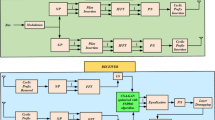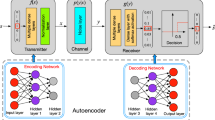Abstract
In recent years, numerous achievements have been made in the field of deep learning, particularly in text processing. In the wave of intelligence, people’s demand for intelligent communication is becoming increasingly higher. Therefore, we consider utilizing deep learning models to design and optimize transceiver of semantic communication system. The research of semantic communication is in a booming stage, but there are still few applications in multi-user scenario. In general, the parameters of the semantic communication system transceiver based on the deep learning model are very large. Therefore, we study the multi-user semantic communication system based on the ALBERT model. The goal of the proposed semantic communication system is to intelligently and correctly send the corresponding text classification to the receiver. The channel state information (CSI) is very important for information transmission. Considering the multi-antenna multi-user uplink scenario, we adopt the conditional generative adversarial network (cGAN) model to estimate CSI and apply it to the proposed semantic communication system. In order to reduce the influence of channel estimation on the delay of communication system, we quantify the pilot at the receiver. The simulation results show that the performance of the semantic communication system proposed in this paper is better than that of the semantic communication system based on Transformer model and the traditional semantic communication system in the intelligent text classification task. Moreover, in the case of low signal-to-noise ratio, traditional communication is difficult to complete intelligent tasks.














Similar content being viewed by others
References
Fu S, Feng X, Sultana A, Zhao L (2023) Joint power allocation and 3d deployment for uav-bss: a game theory based deep reinforcement learning approach. IEEE Transactions on Wireless Communications
Fu S, Wang Y, Feng X, Di B, Li C (2023) Reconfigurable intelligent surface assisted non-orthogonal multiple access network based on machine learning approaches. IEEE Network
Chen M, Challita U, Saad W, Yin C, Debbah M (2019) Artificial neural networks-based machine learning for wireless networks: a tutorial. IEEE Commun Surv Tut 21(4):3039–3071
Strinati EC, Barbarossa S (2021) 6G Networks: beyond shannon towards semantic and goal-oriented communications. Comput Netw 190:107930
Weaver W (1953) Recent contributions to the mathematical theory of communication. ETC: a review of general semantics, pp 261–281
Xie H, Qin Z, Li GY, Juang B-H (2021) Deep learning enabled semantic communication systems. IEEE Trans Signal Process 69:2663–2675
Zaremba W, Sutskever I, Vinyals O (2014) Recurrent neural network regularization. arXiv:1409.2329
O’Shea K, Nash R (2015) An introduction to convolutional neural networks. arXiv:1511.08458
Cambria E, White B (2014) Jumping NLP curves: a review of natural language processing research. IEEE Comput Intell Mag 9(2):48–57
Kountouris M, Pappas N (2021) Semantics-empowered communication for networked intelligent systems. IEEE Commun Mag 59(6):96–102
Yang Y, Guo C, Liu F, Liu C, Sun L, Sun Q, Chen, J (2021) Semantic communications with AI tasks. arXiv:2109.14170
Kalfa M, Gok M, Atalik A, Tegin B, Duman TM, Arikan O (2021) Towards goal-oriented semantic signal processing: applications and future challenges. Digit Signal Process 119:103134
Niu K, DAI J, Zhang P, et al (2021) 6G-Oriented semantic communications. Mob Commun 45(4):85–90
Zhang P, Xu W, Gao H, Niu K, Xu X, Qin X, Yuan C, Qin Z, Zhao H, Wei J et al (2022) Toward wisdom-evolutionary and Primitive-Concise 6G: a new paradigm of semantic communication networks. Eng 8:60–73
Shi G, Xiao Y, Li Y, Gao D, Xie X (2021) Semantic communication networking for the intelligence of everything. Chin J Int Things 5(2):26–36
Bao J, Basu P, Dean M, Partridge C, Swami A, Leland W, Hendler JA (2011) Towards a theory of semantic communication. In: 2011 IEEE Network science workshop, pp 110–117. IEEE
Popovski P, Simeone O, Boccardi F, Gündüz D, Sahin O (2020) Semantic-effectiveness filtering and control for post-5G wireless connectivity. J Indian Inst Sci 100(2):435–443
Farsad N, Rao M, Goldsmith A (2018) Deep learning for joint source-channel coding of text. In: 2018 IEEE International conference on acoustics, speech and signal processing (ICASSP), pp 2326–2330. IEEE
Xie H, Qin Z (2020) A lite distributed semantic communication system for internet of things. IEEE J Sel Areas Commun 39(1):142–153
Weng Z, Qin Z (2021) Semantic communication systems for speech transmission. IEEE J Sel Areas Commun 39(8):2434–2444
Bourtsoulatze E, Kurka DB, Gündüz D (2019) Deep joint source-channel coding for wireless image transmission. IEEE Trans Cognit Commun Netw 5(3):567–579
Lee C-H, Lin J-W, Chen P-H, Chang Y-C (2019) Deep learning-constructed joint transmission-recognition for internet of things. IEEE Access 7:76547–76561
Jankowski M, Gündüz D, Mikolajczyk K (2020) Wireless image retrieval at the edge. IEEE J Sel Areas Commun 39(1):89–100
Xie H, Qin Z, Li GY (2021) Task-oriented multi-user semantic communications for VQA. IEEE Wirel Commun Lett 11(3):553–557
Xie H, Qin Z, Tao X, Letaief KB (2022) Task-oriented multi-user semantic communications. IEEE Journal on Selected Areas in Communications
Weng Z, Qin Z, Tao X, Pan C, Liu G, Li GY (2022) Deep learning enabled semantic communications with speech recognition and synthesis. arXiv:2205.04603
Dong M, Tong L (2002) Optimal design and placement of pilot symbols for channel estimation. IEEE Trans Signal Process 50(12):3055–3069
Coleri S, Ergen M, Puri A, Bahai A (2002) Channel estimation techniques based on pilot arrangement in OFDM systems. IEEE Trans Broadcast 48(3):223–229
Yang B, Letaief KB, Cheng RS, Cao Z (2001) Channel estimation for OFDM transmission in multipath fading channels based on parametric channel modeling. IEEE Trans Commun 49(3):467–479
Shin C, Heath RW, Powers EJ (2007) Blind channel estimation for MIMO-OFDM systems. IEEE Trans Veh Technol 56(2):670–685
Muquet B, De Courville M, Duhamel P (2002) Subspace-based blind and semi-blind channel estimation for OFDM systems. IEEE Trans Signal Process 50(7):1699–1712
Boss D, Petermann T, Kammeyer K-D (1997) Impact of blind Versus Non-Blind Channel Estimation on the BER performance of GSM Receivers. In: Proceedings of the IEEE signal processing workshop on higher-order statistics, pp 62–66. IEEE
Jeremic A, Thomas TA, Nehorai A (2004) OFDM channel estimation in the presence of interference. IEEE Trans Signal Process 52(12):3429–3439
Stuber GL, Barry JR, Mclaughlin SW, Li Y, Ingram MA, Pratt TG (2004) Broadband MIMO-OFDM wireless communications. Proc IEEE 92(2):271–294
Baraniuk RG (2007) Compressive sensing [Lecture Notes]. IEEE Signal Process Mag 24(4):118–121
Rao X, Lau VK, Kong X (2014) CSIT Estimation and feedback for FDD multi-user massive MIMO systems. In: 2014 IEEE International conference on acoustics, speech and signal processing (ICASSP), pp 3157–3161. IEEE
Tropp JA, Gilbert AC (2007) Signal recovery from random measurements via orthogonal matching pursuit. IEEE Trans Inf Theor 53(12):4655–4666
Chun C-J, Kang J-M, Kim I-M (2019) Deep learning-based joint pilot design and channel estimation for multiuser MIMO channels. IEEE Commun Lett 23(11):1999–2003
Kang J-M, Chun C-J, Kim I-M (2020) Deep learning based channel estimation for MIMO systems with received SNR feedback. IEEE Access 8:121162–121181
Creswell A, White T, Dumoulin V, Arulkumaran K, Sengupta B, Bharath AA (2018) Generative adversarial networks: An overview. IEEE Signal Process Mag 35(1):53–65
Yang Y, Gao F, Ma X, Zhang S (2019) Deep learning-based channel estimation for doubly selective fading channels. IEEE Access 7:36579–36589
Mirza M, Osindero S (2014) Conditional generative adversarial nets. arXiv:1411.1784
Lan Z, Chen M, Goodman S, Gimpel K, Sharma P, Soricut R (2019) ALBERT: a lite bert for self-supervised learning of language representations. arXiv:1909.11942
Alkhateeb A (2019) DeepMIMO: a generic deep learning dataset for millimeter wave and massive mimo applications. arXiv:1902.06435
Ronneberger O, Fischer P, Brox T (2015) U-Net: convolutional networks for biomedical image segmentation. In: International conference on medical image computing and computer-assisted intervention, pp 234–241. Springer
Rosenberg JHA (2007) Joint conference on empirical methods in natural language processing and computational natural language learning. V-measure: a conditional entropy-based external cluster evaluation measure. Lecture notes in artificial intelligence. Prague: Association for computational linguistics
Li J, Sun M, Zhang X (2006) A comparison and semi-quantitative analysis of words and character-bigrams as features in chinese text categorization. In: proceedings of the 21st international conference on computational linguistics and 44th annual meeting of the association for computational linguistics, pp 545–552
Funding
This work was supported in part by the National Natural Science Foundation of China under Grants 62271093, U21A20448, and U20A20157.
Author information
Authors and Affiliations
Contributions
HM.D., WQ.W., and M.L. wrote the main manuscript text. All authors reviewed the manuscript.
Corresponding author
Ethics declarations
Competing interests
The authors declare no competing interests.
Additional information
Publisher's Note
Springer Nature remains neutral with regard to jurisdictional claims in published maps and institutional affiliations.
Rights and permissions
Springer Nature or its licensor (e.g. a society or other partner) holds exclusive rights to this article under a publishing agreement with the author(s) or other rightsholder(s); author self-archiving of the accepted manuscript version of this article is solely governed by the terms of such publishing agreement and applicable law.
About this article
Cite this article
Deng, H., Wang, W. & Liu, M. Deep Learning Enabled Task-Oriented Semantic Communication for Memory-Limited Devices. Mobile Netw Appl (2023). https://doi.org/10.1007/s11036-023-02267-8
Accepted:
Published:
DOI: https://doi.org/10.1007/s11036-023-02267-8




